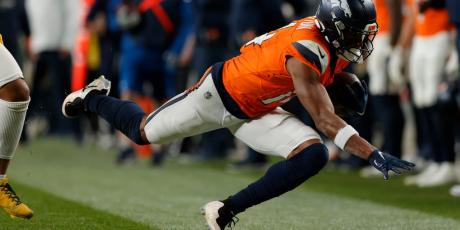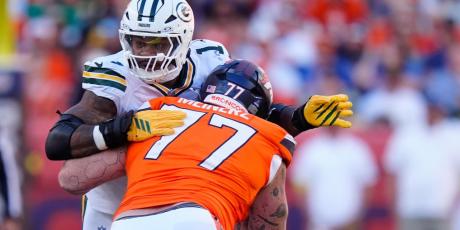The Case for Jimmy Graham

Prior to the 2012 season, Value-Based Rankings (VBR) typically showed that the top tight end held 3rd-round value. Oftentimes, these players -- Jason Witten in 2008 and 2009, Antonio Gates in 2010 and 2011 -- were being drafted in the late 3rd or early 4th rounds, so they held good value in the 3rd round on draft day.
In 2012, Jimmy Graham and Rob Gronkowski led the way in preseason TE value and both players held 2nd round (and sometimes 1st round) value, depending on format. Graham struggled with wrist and ankle injuries throughout the season, but still played 15 games and finished as the #1 TE, catching 85 passes for 982 yards and nine TDs.
Graham's Current Value
Graham's perceived 2013 value has increased in the past few weeks due to what's been happening in New England with Rob Gronkowski's back surgery and the fact that police have been searching the home, pond and the "luxury doghouse" of Aaron Hernandez in connection with the murder of one of his associates/acquaintances.
For tight ends, we use the #12 TE as the baseline in 12-team leagues. It's important to note that Graham may not have moved much in terms of VBR because it's not like the #12 TE in our rankings, Brandon Myers, is involved in a murder investigation. So Graham's value is relative to Myers in this situation. However, given the increased drop-off to the next group of players, Graham's share of the total projected points scored by the top 12 tight ends has increased dramatically because we were forced to rein in our expectations for Gronkowski and Hernandez. With Gronkowksi and Hernandez iffy, it means that on draft day, Graham should give his owners an increased advantage over the rest of the league.
Is It Wise to Target a TE Early?
I've read a few articles recently making the case against drafting Graham in the early (i.e. 2nd or 3rd) rounds this season and the argument seems to boil down to the following points:
1. Graham plays tight end which is typically a low-demand position. Most leagues require only one starting tight end (if that), so the position has a lower demand than other mulitple-start positions like RB and WR. This means that teams will often forgo drafting/rostering a TE2 which means more tight ends are available on the waiver wire in any given week. This means that…
2. It's easy to stream tight ends. More options on the waiver wire means that it's more likely that a tight end with a favorable matchup will be available in any given week. For 10- or 12-team leagues with rosters of 16 or fewer, it's definitely easy to find a TE with a favorable matchup on the waiver wire. In leagues with more teams and/or larger roster sizes, it's not so easy.
3. The opportunity cost of drafting Graham is too high. By drafting a tight end in the 2nd or 3rd round, owners aren't drafting another position of higher demand, like RB or WR.
These are all valid arguments, but there are other characteristics that Graham possesses that should be taken into consideration:
- He's finally healthy and early reports have him playing at a high level in OTAs.
- He's in a contract year, so he will be motivated to produce.
- He plays with a great quarterback (Drew Brees) in one of the best pass offenses in the league. Plus, HC Sean Payton is back in the fold.
It all adds up to Graham being a very low-risk pick, and those are the types of players I'm looking to draft in the early rounds. It's difficult to win your league in the 1st or 2nd round, but it's easy to lose it. I'll begin to bite on some risky upside in the 3rd round, but I want my first two picks to be rock solid.
2nd Round Strategy
Graham is rock solid, especially when you start to compare him with the other players in the 2nd round, specifically the RBs. After Matt Forte and Steven Jackson, things start to get dicey at the RB position with Maurice Jones-Drew (Lisfranc injury, new running scheme) and Chris Johnson (Shonn Greene vulturing goal line carries). DeMarco Murray, Frank Gore, David Wilson and Darren McFadden all have their own issues making them iffy picks in the 2nd. Looking at these RBs, I don't see a big difference between those going in the 2nd round (CJ1K, MJD) and those that will be available in the 3rd round (DMC, Murray, Gore, Lamar Miller, etc.). So, in most formats, I'd take Graham over all backs but Forte and Jackson. Depending on the format, I'd also take Stevan Ridley (in standard) and Darren Sproles (in PPR) over Graham.
What about drafting a wide receiver in the 2nd? This is not a bad strategy, but the depth at WR is incredible this season, with the #10 WR (Andre Johnson) and the #37 WR (Miles Austin) separated by just 28 projected points.
To illustrate, let's say my plan is to either grab Graham in the 2nd round, or wait until the 7th round to take whoever is left of the next group -- Tony Gonzalez, Jason Witten, Dennis Pitta or Vernon Davis. To compare the two options, we should project the total number of fantasy points scored by my 2nd/7th round duo.
In the case of Graham/WR, we can expect someone like Steve L Smith (151 FP), Danario Alexander (148) or Anquan Boldin (146) to be available in the 7th round. Adding the average of those three WRs (148.3) to Graham's projection (182) and we can expect to score 330.3 FP from those two draft picks.
Conversely, let's say we draft one of the top WRs likely available in the 2nd round -- Dez Bryant, Brandon Marshall or Demaryius Thomas -- who have an average of 192.0 projected FP scored. If we're lucky enough to get Gonzo (139 FP) in the 7th, we will have a projected 331.0 FP from our WR/TE combo, an increase of 0.7 FP over the course of the season. Not a big deal, but comparable. But what if Gonzo (6.11 ADP) is gone? An average of Witten, Pitta and Davis yields a total of 309.0 projected FP, which is 21.3 FP less than the Graham/WR combo, or 1.3 FP per week. That's significant.
Another way to look at it is that the wideout drafted in the 7th round is likely to outscore whatever tight end that is available at that point in the draft, and by a fairly wide margin. And you're getting near-WR1 production out of Graham in the 2nd round.
What about Greg Olsen (108 FP), you say? He's a sneaky value pick in the 9th or 10th round, but to counter that I'd point to Lance Moore (141), Denarius Moore (132), Michael Floyd (122) and Emmanuel Sanders (118), who are all going at about the same point in the draft as Olsen and are projected to score more fantasy points.
Note: Keep in mind that as position requirements change, so does Graham's value relative to other positions. For example, if a league requires three starting WRs, a few of the top tier WRs (like A.J. Green and Dez Bryant) move ahead of Graham. I'd still argue that it's fairly easy to fill three starting WR slots with good production later in the draft when someone like Moore is available in the 8th or 9th round.
The Downside of Streaming
You'll get no argument from me -- streaming is oftentimes an excellent way to get good production out of a roster spot, whether it be a quarterback, tight end, kicker or defense. But as a top 5 ranker -- ahem, for an unprecedented three straight seasons -- tight end was the most difficult position for me to rank in 2012, and the 2013 season is shaping up in the same way. There looks to be only a handful of "every week" starters, along with 10 or 15 players who can out-produce their peers in any given week. Some might say that this supports the argument for streaming, but as a person who plays in multiple leagues, I'm looking to minimize my weekly waiver work, not create more decisions for myself. I'd be far more inclined to stream QBs or TEs if I were only in one or two leagues.
Tight ends are difficult to rank because they are so TD-dependent compared to other positions. Touchdowns are more difficult to predict than more common events like receptions and receiving yards, so the fact that the position relies so heavily on the endzone in its scoring makes it tougher to pick out the "winners" in any given week. This makes it more difficult to successfully stream.
That reminds me -- another nice thing about Graham is that he's not TD-dependent. He has gained 50+ yards in 27 of his last 33 games, so you're getting consistency at a position that is not very consistent.
The Bottom Line
As far as a draft plan goes, in most standard formats I'm targeting Jimmy Graham in the second round if the top 12-13 RBs are already off the board. If I miss out on Graham, then I'm looking to draft Gonzalez, Witten, Pitta or Davis in the 6th-7th rounds. I would consider the ever-steady Gonzo in the late 5th given the current state of the TE position. If I miss that tier, I'm looking for Olsen in the 9th or 10th round. If I can't get him, I'm looking to draft a couple of upside TEs like Jordan Cameron [Sleeper Alert] or Rob Housler [Sleeper Alert] and hoping one can produce starter-caliber numbers. Owen Daniels is another player who has limited upside but should finish in the TE10-TE14 range if he can stay healthy.
In PPR formats, I will pass on Graham for Darren Sproles, who is a great value anywhere in the 2nd round. I would then hope for Graham in the 3rd, but if he's gone I would proceed with the plan outlined above.
Things could change quickly if Gronkowski's back heals quickly or if Hernandez can get the police out of his doghouse, but given the current state of the two New England tight ends, Jimmy Graham is looking better than ever right now.












